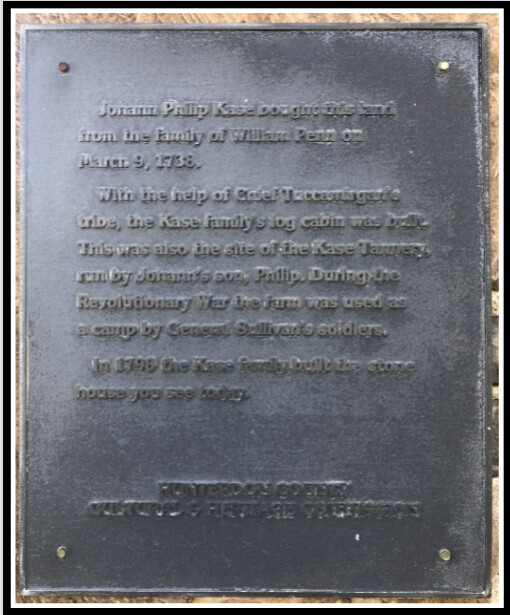(Part 1 of an ongoing series: The historic Case-Dvoor Farmstead, which serves as the Hunterdon Land Trust’s headquarters, tells a fascinating story of our county’s agricultural heritage, local architecture from the mid-18th century, and the history of the region. This property is one of the last remaining examples of the farms that once ringed Flemington.)
The site of the Case-Dvoor farmstead lies near the eastern end of a 5,000-acre tract that stretches along the northern edge of the Amwell Valley. Pennsylvania founder William Penn owned the land, and when he died in 1718, his three sons inherited it. Those sons — John, Thomas and Richard — subdivided the property, selling a 374-acre portion straddling Tuccaminjah Creek (later Mine Brook) to German immigrant Johan Philip Kaes (later Anglicized to Case) in March of 1738.
Johan Philip Kaes was born sometime between 1673 and 1680 in Anshausen, Rheinland, Germany. He married his first wife, Anna Elisabetha Jung, on Nov. 29, 1703. The couple likely arrived in America between 1718 and 1721.
According to local legend, Johan Philip built a log cabin not far from encampment of Chief Tuccamirgan with the help of local tribesmen. The childless chief and his wife grew fond of Case’s children and had a gum log scooped out to serve as a cradle. The chief’s wife cared for Case’s babies as if they were her own, according to local history.
Upon his death in 1750, Chief Tuccamirgan was buried in the Case family graveyard. His funeral took place at sunset, and he was buried facing east in an upright position with blankets, pipes, knives, etc. — such things that he might need in the afterlife. His resting place is marked today by a stone monument at the burial ground along Bonnell Street, Flemington, inscribed “In memory of the Delaware Indian Chief, Tuccamirgan: This lasting memorial was erected by patriotic and historical organizations in 1925.”
A rather peculiar story handed down in the Case family evokes the frontier conditions current throughout much of Hunterdon County well into the 18th century. One of Johan Philip’s sons:
used to tell about his mother getting lost in the woods. She went to hunt her cow and wandered around for several hours and finally saw a column of smoke curling above the tops of the trees. Going in that direction she came to a house, and, after knocking at the door, discovered it to be her own dwelling. . . The wolves would often howl around the Case house, and one of these animals came on the door step and attacked the dog, when Mrs. Case drove him off with a stick.
Johan Philip Case replaced his pioneer dwelling with a substantial stone house cemented with mud that stood on the east side of the creek (the land currently owned by St. Magdalen di Pazzi Roman Catholic Church). When Hugh Capner tore the house down around the 1850s, he found the walls solid and strong.
Johan Philip Case married twice and may have had eight children with his first wife and four with his second, Rachel Hauser.* He died in 1756 “at an advanced age” and presumably is buried in the Case family graveyard on Bonnell Street in Flemington, although no stone marks his grave. His property was divided among his heirs and portions of it were sold. (You can read his will here.)
Philip Case (Johan Philip’s son) acquired the property on the west side of the creek encompassing the present farmstead, which had been sold out of the family some years earlier. He lived and farmed here throughout his life.
The land on the east side of the creek, including Johan Philip’s stone house, was sold to John Capner, whose family had recently emigrated from England. We know much about the Case family thanks to the Capners, who corresponded regularly with the relatives and arrived in America with a trunk full of letters from them. These letters now belong to the Hunterdon County Historical Society. (To be continued…)
*Family genealogical records list: Eva Maria, Anna (married Henry Dilts), Maria Catharina (died June 11, 1722, age 12), Johan Valentin (died July 21, 1721, age 8 and the twin of Johan Wilhelm), Veronika Frona Catherine (married Heinrich Winter), Anna Elizabeth (married Peter Aller) and Johann Jacobus.
(Information for this blog was compiled from online genealogical records, the Case-Dvoor Farmstead filing on the National Register of Historic Places and various other sources including: Case-Dvoor Farmstead: Historical Assessment Report, Dvoor Farmstead Feasibility Study by Dennis Bertland Associates, Dec. 2001; James P. Snell, History of Hunterdon and Somerset Counties, New Jersey, 1881; Henry Z. Jones, Jr., More Palatine Families-Some Immigrants To The Middle Colonies 1717 – 1776 & Their European Origins Plus New Discoveries on Germans Families who Arrived in Colonial New York in 1710, 1991.)






